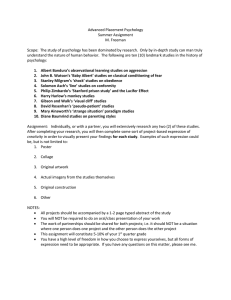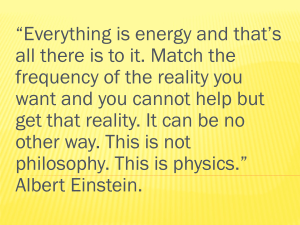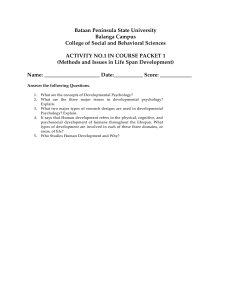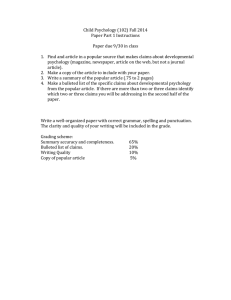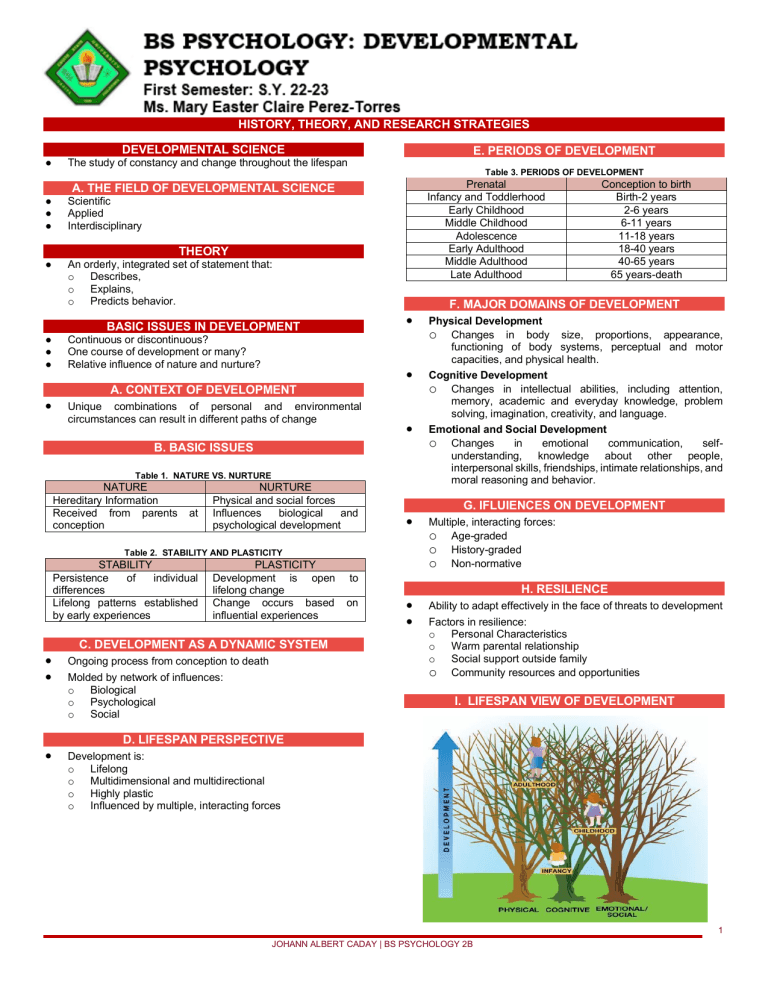
HISTORY, THEORY, AND RESEARCH STRATEGIES DEVELOPMENTAL SCIENCE ● E. PERIODS OF DEVELOPMENT The study of constancy and change throughout the lifespan Table 3. PERIODS OF DEVELOPMENT Prenatal Infancy and Toddlerhood Early Childhood Middle Childhood Adolescence Early Adulthood Middle Adulthood Late Adulthood A. THE FIELD OF DEVELOPMENTAL SCIENCE ● ● ● Scientific Applied Interdisciplinary ● An orderly, integrated set of statement that: o Describes, o Explains, o Predicts behavior. THEORY • BASIC ISSUES IN DEVELOPMENT ● ● ● • Continuous or discontinuous? One course of development or many? Relative influence of nature and nurture? • A. CONTEXT OF DEVELOPMENT Unique combinations of personal and environmental circumstances can result in different paths of change • B. BASIC ISSUES Table 1. NATURE VS. NURTURE NATURE Hereditary Information Received from parents conception at NURTURE Physical and social forces Influences biological and psychological development • Table 2. STABILITY AND PLASTICITY STABILITY Persistence of individual differences Lifelong patterns established by early experiences • • • PLASTICITY Development is open lifelong change Change occurs based influential experiences C. DEVELOPMENT AS A DYNAMIC SYSTEM Ongoing process from conception to death Molded by network of influences: o Biological o Psychological o Social Conception to birth Birth-2 years 2-6 years 6-11 years 11-18 years 18-40 years 40-65 years 65 years-death F. MAJOR DOMAINS OF DEVELOPMENT Physical Development o Changes in body size, proportions, appearance, functioning of body systems, perceptual and motor capacities, and physical health. Cognitive Development o Changes in intellectual abilities, including attention, memory, academic and everyday knowledge, problem solving, imagination, creativity, and language. Emotional and Social Development o Changes in emotional communication, selfunderstanding, knowledge about other people, interpersonal skills, friendships, intimate relationships, and moral reasoning and behavior. G. IFLUIENCES ON DEVELOPMENT Multiple, interacting forces: o Age-graded o History-graded o Non-normative to on • • H. RESILIENCE Ability to adapt effectively in the face of threats to development Factors in resilience: o Personal Characteristics o Warm parental relationship o Social support outside family o Community resources and opportunities I. LIFESPAN VIEW OF DEVELOPMENT D. LIFESPAN PERSPECTIVE Development is: o Lifelong o Multidimensional and multidirectional o Highly plastic o Influenced by multiple, interacting forces 1 JOHANN ALBERT CADAY | BS PSYCHOLOGY 2B SCIENTIFIC BEGINNINGS BEHAVIORISM AND SOCIAL LEARNING THEORY • • • • • • EARLY SCIENTIFIC THEORIES Theory of evolution o Natural selection o Survival of the fittest Normative approach o Child study movement o Development as a maturational process Mental testing movement o First successful intelligence test o In forefront of nature–nurture controversy PSYCHOANALYTIC PERSPECTIVE (FREUD AND ERIKSON) Emphasis on individual’s unique life history Conflicts between biological drives and social expectations A. FREUD’S THREE PARTS OF THE PERSONALITY • • • • • • • • Sensorimotor Preoperational Concrete operational Formal operational • • • • View of the human mind as a symbol-manipulating system Development as a continuous process Use of rigorous research methods Little insight into creativity or imagination • B. FREUD’S PSYCHOSEXUAL STAGES Oral Anal Phallic Latency Genital PIAGET’S COGNITIVE-DEVELOPMENTAL THEORY Children actively construct knowledge by manipulating and exploring their world. Mental structures adapt to better fit with environment. Development moves through four broad stages. • • • • • • Contributions: o Behavior modification o Modeling, observational learning Limitations: o Narrow view of environmental influences o Underestimates individual’s active role • • C. ERIKSON’S PSYCHOSOCIAL STAGES • A. PIAGET’S STAGES B. INFORMATION PROCESSING DEVELOPMENTAL COGNITIVE NEUROSCIENCE Relationship of brain changes to cognitive processing and behavior patterns Brings together researchers from o Psychology o Biology o Neuroscience o Medicine o Practical applications ETHOLOGY Adaptive value and evolutionary history of behavior Acquisition of adaptive behaviors: o critical period o sensitive period EVOLUTIONARY DEVELOPMENTAL PSYCHOLOGY Adaptive value of o cognitive o emotional o social competencies as they change with age • Person–environment system throughout the lifespan 2 JOHANN ALBERT CADAY | BS PSYCHOLOGY 2B • • VYGOTSKY’S SOCIOCULTURAL THEORY Transmission to the next generation of a culture’s o values o beliefs o customs o skills Cooperative dialogues between children and more expert members of society • • • D. ETHNOGRAPHY Participant observation of culture or social group Rich, descriptive insights Does not permit generalization from findings GENERAL RESEARCH DESIGN Table 1. RESEARCH DESIGN CORRELATIONAL Reveals relationships between participants’ characteristics and behavior Does not permit cause-andeffect inferences ECOLOGICAL SYSTEMS THEORY EXPERIMENTAL Participants randomly assigned to treatment conditions Detects cause-and-effect relationships Findings may not apply in realworld conditions A. CORRELATIONAL COEFFICIENTS • • Layers of the environment: o microsystem o mesosystem o exosystem o macrosystem Chronosystem: temporal dimension COMMON RESEARCH METHODS B. EXPERIMENTAL DESIGN A. SYSTEMATIC OBSERVATION Table 2. EXPERIMENTAL DESIGN Table 1. SYSTEMATIC OBSERVATION NATURALISTIC OBSERVATION Observation of behavior in natural contexts Reflects participants’ everyday lives STRUCTURE OBSERVATION Observation of behavior in laboratory Gives all participants opportunity to display behavior • Table 2. SELF-REPORT Probes for participant’s viewpoint Provides large amount of information in brief period • • Expected to cause changes in another variable • B. SELF-REPORT CLINICAL INTERVIEW Conversational style INDEPENDENT VARIABLE Manipulated by experimenter STRUCTURED INTERVIEW All participants are asked the same questions in the same way Permits comparisons and efficient data collection C. CLINICAL/CASE STUDY METHOD DEPENDENT VARIABLE Measured, but not manipulated, by experimenter Expected to be influenced by independent variable C. RANDOM ASSIGNMENT Unbiased procedure used to assign participants to treatment conditions Increases chances that characteristics will be equally distributed across conditions D. MODIFIED EXPERIMENTS Table 1. MODIFIED EXPERIMENTS FIELD EXPERIMENT Conducted in natural settings Capitalizes Opportunities assignment on for existing random DEPENDENT VARIABLE Compares existing differences in treatment Participant groups matched as much as possible Full picture of individual’s psychological functioning Combines information from o Interviews o Observations o Test scores 3 JOHANN ALBERT CADAY | BS PSYCHOLOGY 2B DEVELOPMENTAL RESEARCH DESIGN • • • A. PROBLEMS IN CONDUCTING LONGITUDINAL RESEARCH Participants dropout Practice effects Cohort Effects B. IMPROVING DEVELOPMENTAL DESIGN • • Sequential designs o Compare several similar cross-sectional or longitudinal studies o Permit longitudinal and cross-sectional comparisons Combining experimental and developmental designs o Experimental manipulation of experiences o Provides evidence of causal association between experiences and development • • • • • Protection from harm Informed consent Privacy Knowledge of results Beneficial treatments RIGHTS OF RESEARCH PARTICIPANTS 4 JOHANN ALBERT CADAY | BS PSYCHOLOGY 2B GENETIC AND ENVIRONMENTAL FOUNDATION GENOTYPE AND PHENOTYPE Table 1. GENOTYPE AND PHENOTYPE GENOTYPE An individual’s genetic information PHENOTYPE An individual’s directly observable characteristics GENETIC FOUNDATIONS • • • • • • DOMINANT-RECESSIVE INHERITANCE Only the dominant allele affects children’s phenotypic characteristics Carriers: o heterozygous (have one recessive allele) o can pass recessive trait to their children Many serious diseases are product of recessive alleles INCOMPLETE DOMINANCE Both alleles are expressed in the phenotype Possible results: o combined trait o trait that is intermediate between the two Example: sickle cell anemia X-LINKED INHERITANCE MITOSIS AND MEIOSIS Table 2. MITOSIS AND MEIOSIS MITOSIS Process by which DNA duplicates itself Produces new body cells containing the same genetic information MEIOSIS An individual’s directly observable characteristics Halves the number of chromosomes normally present Leads to genetic variability AUTOSOMES, SEX, CHROMOSOMES, AND SEX CELLS • • • GENOMIC IMPRINTING, MUTATION, AND POLYGENIC INHERITANCE Genomic imprinting: o chemical marker activates one allele in a pair o often temporary; may not occur in all individuals Mutation: o sudden, permanent change in a segment of DNA o may affect one or two genes, or many Polygenic inheritance: o characteristics influenced by many genes TWINS Table 3. TWINS FRATERNAL/DIZYGOTIC Result from release and fertilization of two ova • • IDENTICAL/MONOZYGOTIC Result when a single zygote separates to form two individuals ALLELES Two forms of the same gene, one inherited from each parent o homozygous (both alleles are alike) o heterozygous (alleles differ) Occur at the same place on both chromosomes in a pair CHROMOSAL ABNORMALITIES • • Down syndrome: caused by problems with 21st chromosome Sex chromosome abnormalities: o caused by problems with X or Y chromosome o often not recognized until adolescence • • • • Genetic counseling Prenatal diagnosis and fetal medicine Reproductive technologies Adoption REPRODUCTIVE CHOICES 5 JOHANN ALBERT CADAY | BS PSYCHOLOGY 2B A. REPRODUCTIVE TECHNOLOGIES • • • • Donor insemination In vitro fertilization Surrogate motherhood New technologies • • Helps couples o assess chances of hereditary disorders o choose best course of action in view of risks and family goals Recommended when o couple has had difficulties bearing children o known genetic problems exist o woman is over 35 • • • • • • • Amniocentesis Chorionic villus sampling Fetoscopy Ultrasound Maternal blood analysis Ultrafast magnetic resonance imaging Preimplantation genetic diagnosis • Trends: o International adoption o adoption of older children o adoption of children with known developmental problems Children typically exhibit some difficulties, but most fare well • • • • • • • Most homeless families are women with children under age 5 Many homeless children suffer from: o developmental delays o chronic emotional stress o 25% to 30% of school-age homeless children do not attend school • What Are the Risks of Affluence? o Alcohol and drug use o High levels of anxiety and depression o Unavailable parents: ▪ lack of emotional closeness and supervision ▪ excessive demands for achievement C. HOMELESSNESS C. PARENTAL DIAGNOSTIC METHODS D. ADOPTION AFLUENCE IMPORATNCE OF REGULARLY EATING DINNER AS A FAMILY ENVIRONMENTAL CONTEXTS FOR DEVELOPMENT Family Socioeconomic status and family functioning Neighborhoods, towns, and cities Cultural context FAMILY INFLUENCES ON DEVELOPMENT Direct influences Indirect influences: effects of third parties Adaptation to changes within and outside the family • Social status: o years of education o prestige of one’s job and skill it requires Economic status: income • 46 million Americans (15%) are poor Those hit hardest are: o parents under age 25 with young children, especially single mothers o older adults who live alone, especially women o children, especially African-American, Native-American, and Hispanic children B. GENETIC COUNSELING • • • • B. POVERTY (WHO IS POOR?) • • ECONOMIC STATUS (SES) A. SOCIOECONOMIC STATUS AND FAMILY FUNCTIONING SES is linked to: o timing of marriage and parenthood o family size o values and expectations for children o parents’ education and economic security o communication and discipline styles o investment in children’s cognitive development • BEYOND THE FAMILY Benefits of Strong Community Ties o Neighborhoods: resources and social ties that promote development o Towns and cities: mold children’s and adults’ daily lives o Small towns: promote connection and participation 6 JOHANN ALBERT CADAY | BS PSYCHOLOGY 2B • • • • • • CULTURAL CONTEXT PERCENTAGE OF OLDER ADULTS LIVING IN POVERTY Cultural values and practices: shape daily life within and outside the family Subcultures: o cooperative family structures help protect members from harmful effects of poverty o collectivism vs. individualism Public policies: laws and programs designed to improve current conditions EXTENDED FAMILIES Three or more generations living together More common in many minority cultures Benefits: o reduce stress of poverty o provide assistance for all generations o create strong family bonds o transmit culture to next generation INDVIDUALISTIC AND COLLECTIVIST SOCIETIES Table 4. Individualistic vs Collectivist Individualistic People define themselves as separate entities Independent self Collectivist People define themselves as part of a group Interdependent self INDICATORS OF CHILDREN’S HEALTH AND WELLBEING BEHAVIORAL GENETICS • • • • • • • • A. HOW MUCH DOES HEREDITY CONTRIVUTE TO BEHAVIOR Heritability Estimates Obtained from kinship studies Provide an estimate of proportion of individual differences in a trait attributable to heredity Range from 0 to 1.00 B. GENE-ENVIRONMENT INTERACTION Individuals respond differently to same environment because of genetic makeup Similar responses can result from different gene–environment combinations C. CANALIZATION Tendency of heredity to restrict development of some characteristics to just one or a few outcomes Ensures development of species-typical skills under many rearing conditions 7 JOHANN ALBERT CADAY | BS PSYCHOLOGY 2B D. GENE-ENVRIONMENT CORRELATION • • • Passive correlation Evocative correlation Active correlation: niche-picking • Development results from bidirectional exchanges between heredity and all levels of environment Genes affect behavior and experiences Experiences and behavior affect gene expression • • E. EPIGENESIS The Epigenetic Framework 8 JOHANN ALBERT CADAY | BS PSYCHOLOGY 2B PRENETAL DEVELOPMENT, BIRTH, AND THE NEWBORN BABY PERIODS OF PRENATAL DEVELOPMENT • • • • • • D. TERATOGENS Harm done by teratogens is affected by: dose heredity age other negative influences Delayed health effects may show up decades later Teratogenic substances • A. CONCEPTION AND IMPLANTATION • • • • • • • • B. PERIOD OF THE FETUS Third month: o organs, muscles, and nervous system start to become organized and connected o lungs begin to expand and contract Second trimester: o many organs are well-developed by 20 weeks o most of the brain’s neurons are in place Third trimester: o age of viability: 22–26 weeks o fetus takes on beginnings of personality C. SENSITIVE PERIODS IN PRENATAL DEVELOPMENT Drugs: o prescription o nonprescription o illegal Tobacco Alcohol Radiation Environmental pollution Infectious disease E. OTHER MATERNAL FACTORS IN PREANTAL DEVELOPMENT • • • • • Nutrition Emotional stress Rh factor incompatibility Age Lack of prenatal health care • • • • • • • Monitor general health: weight gain capacity of uterus and cervix to support fetus growth of the fetus Treat complications: diabetes preeclampsia • • • Dilation and effacement of the cervix Delivery of the baby Delivery of the placenta IMPORTANCE OF PREANTAL CARE STAGES OF CHILDBIRTH STAGES OF LABOR 9 JOHANN ALBERT CADAY | BS PSYCHOLOGY 2B THE BABY’S ADAPTATION TO LABOR AND DELIVERY • High levels of stress hormones o help baby withstand oxygen deprivation o prepare baby to breathe o arouse infant into alertness • • • THE APGAR SCALE INTERVENTIONS FOR PRETERM INFANTS Temperature-controlled isolette Special stimulation: o gentle rocking o visual or auditory stimulation o touch, such as skin-to-skin kangaroo care Parent training in infant caregiving INFANT MORTALITY IN THIRTY NATIONS NATURAL, OR PREPARED, CHILDBIRTH • • • Classes Relaxation and breathing techniques Labor coach: friend, relative, or trained doula • • Anoxia (oxygen deprivation) Breech position • • Fetal monitoring Labor and delivery medication o analgesics o anesthetics Cesarean delivery • BIRTH COMPLICATIONS MEDICAL INTERVENTIONS IN CHILDBIRTH PRETERM AND SMALL-FOR-DATE INFANTS Table 1. Preterm vs small-for-Date Preterm Born several weeks or more before their due date Weight may be appropriate for length of pregnancy Small-for-Date May be either preterm or fullterm Below expected weight for length of pregnancy PREGNANCY LENGTH AND INFANT SURVIVAL/DISABILITY BIRTH COMPLICATIONS AND RESILIENCE • • • Severe birth trauma is associated with long-term difficulties Effects of mild to moderate trauma depend on environment Resilience plays a role in long-term adjustment • • • • • • • • Eye blink Rooting Sucking Moro Palmar grasp Tonic neck Stepping Babinski NEWBORN REFLEXES 10 JOHANN ALBERT CADAY | BS PSYCHOLOGY 2B INFANT STATES OF AROUSAL • • • • • Rapid-eye-movement (REM) sleep Non-rapid-eye-movement (NREM) sleep Drowsiness Quiet alertness Waking activity and crying • • • • • • • • Talk softly or play rhythmic sounds Offer pacifier Massage baby’s body Swaddle Hold on shoulder, rock or walk Go for car ride or swing in cradle Combine methods Let cry for short time • • SOOTHING A CRYING BABY • • • NEWBORN AND THEIR SENSES A. NEWBORN SENSE OF TOUCH • • • • • • • Sensitive to touch around mouth on palms and soles of feet Use touch to investigate their world Severe pain overwhelms nervous system with stress hormones can be relieved with local anesthesia, sugar solution, or physical touch • Infants o have a preference for sweet tastes at birth o can readily learn to like new tastes o have odor preferences at birth o can locate odors and identify mother by smell from birth • Newborns o can hear a wide variety of sounds o prefer complex sounds to pure tones o can distinguish between a variety of sound patterns when only a few days old o listen longer to human speech than to nonspeech sounds o can detect the sounds of any human language • • • • • • Least developed sense at birth Limited visual acuity Actively explore environment: scan for interesting sights track moving objects Not yet good at discriminating colors • NEONATAL BEHAVIORAL ASSESMENT SCALE (NBAS) Evaluates newborn reflexes, state changes, responsiveness to physical and social stimuli Used to o discover individual and cultural differences o help parents get to know their babies Changes in scores reveal baby’s ability to recover from stress of birth Neonatal Intensive Care Unit Network Neurobehavioral Scale (NNNS): similar instrument used for at-risk infants NEW FAMILY ADJUSTMENT Hormones that facilitate caregiving: o oxytocin o prolactin o estrogens o Hormonal effects may depend on experience Challenges of early weeks: o new roles o changed schedule B. NEWBORN SENSES OF TASE AND SMELL C. NEWBORN SENSE OF HEARING D. NEWBORN SENSE OF VISION 11 JOHANN ALBERT CADAY | BS PSYCHOLOGY 2B PHYSICAL DEVELOPMENT IN INFANCY AND TODDLERHOOD • • • • • • • • • BODY GROWTH REGIONS OF THE CEREBRAL CORTEX Height increases 50% by age 1, 75% by age 2 Weight doubles by 5 months, triples by 1 year Growth occurs in spurts Individual and group differences in size and rate of growth INDIVIDUAL AND GROUP DIFFERENCES IN GROWTH Group differences: male/female ethnic Individual differences Skeletal age: best estimate of physical maturity GROWTH TRENDS Table 1. Changes in body proportions Cephalocaudal “Head to tail” Lower part of body grows later than the head Proximodistal “Near to far” Extremities grow later than head, chest, and trunk NEURONS AND THEIR CONNECTIVE FIBERS • • A. PREFRONTAL CORTEX Region of the cerebral cortex responsible for thought, especially: o consciousness o inhibition of impulses o integration of information o use of memory, reasoning, planning, and problem-solving strategies Undergoes rapid growth in the preschool and school years, and in adolescence MAJOR MILESTONES OF BRAIN DEVELOPMENT B. LATERALIZATION OF THE CERBRAL CORTEX Table 2. Lateralization of the Cerebral Cortex Left Hemisphere Verbal abilities Positive emotion Sequential, analytic processing • • • • • C. BRAIN PLASTICITY • • • • At birth, hemispheres have begun to specialize Highly plastic cerebral cortex has high capacity for learning If part of cortex is damaged, other areas can take over its tasks Older children and adults retain some plasticity, but less than in young children • • Appropriate stimulation is vital for brain growth Experience-expectant growth: depends on ordinary experiences Experience-dependent growth: additional growth resulting from specific learning experiences METHODS FOR MEASURING BRAIN FUNCTIONING Electroencephalogram (EEG) Event-related potentials (ERPs) Functional magnetic resonance imaging (fMRI) Positron emission tomography (PET) Near-infrared spectroscopy (NIRS) Right Hemisphere Spatial abilities Negative emotion Holistic, integrative processing • SENSITIVE PERIODS IN BRAIN DEVELOPMENT 12 JOHANN ALBERT CADAY | BS PSYCHOLOGY 2B • • • • • CHANGING STATES OF AROUSAL OPERANT CONDITIONING Table 3. Sleep–wake pattern moves to night–day schedule during first year By age 2, total sleep time declines from 18 to 12 hours per day Sleep patterns are affected by social environment, cultural values INFLUENCES ON EARLY GROWTH • Heredity Nutrition: o breastfeeding vs. bottle-feeding o risks of overfeeding Malnutrition • • • • • • • Correct balance of fat and protein Ensures nutritional completeness Helps ensure healthy physical growth Protects against disease Protects against faulty jaw and tooth development Ensures digestibility Smooths transition to solid food Operant Conditioning Reinforcer Increases probability that behavior will occur again by presenting desirable stimulus removing unpleasant stimulus Punishment Reduces probability that behavior will occur again by presenting unpleasant stimulus removing desirable stimulus USING HABITUATION TO STUDY INFANT MEMORY AND KNOWLEDGEs A. BENEFITS OF BREASTFEEDING B. MALNUTRITION • • • • IMITATION Infants are born with primitive ability to imitate Mirror neurons provide biological explanation Powerful means of learning Helps facilitate positive relationships MOTOR DEVELOPMENT THE STEPS OF CLASSICAL CONDITIONING A. SEQUENCE AND TRENDS • • • • Gross-motor development: crawling, standing, walking Fine-motor development: reaching, grasping Sequence is fairly uniform Large individual differences in rate of motor progress • Mastery involves acquiring increasingly complex systems of action with each skill Each new skill is joint product of o central nervous system development o the body’s movement capacity o the child’s goals o environmental supports for the skill • • • • • B. MOTOR SKILLS AS DYNAMIC SYSTEMS C. CULTURAL VARIATIONS IN MOTOR AND DEVELOPMENT Rates and patterns of development affected by early movement opportunities environmental stimulation child-rearing practice 13 JOHANN ALBERT CADAY | BS PSYCHOLOGY 2B • • • • MILESTONES OF REACHING AND GRASPING SUBJECTIVE BOUNDARIES IN VISUAL PATTERNS Prereaching Ulnar grasp Transferring object from hand to hand Pincer grasp DEVELOPMENTS IN HEARING MILESTONES IN FACE PERCEPTION VISUAL DEVELOPMENT • • Supported by rapid maturation of eyes and visual centers in brain Improvements: o 2 months: focus o 4 months: color vision o 6 months: acuity, scanning, and tracking o 6–7 months: depth perception MILESTONES IN DEPTH PERCEPTION A. EARLY FACE PERCEPTION • The Visual Cliff Reveals link between crawling and depth perception MILESTONES IN INTERMODAL PERCEPTION MILESTONES IN PATTERN PERCEPTION 14 JOHANN ALBERT CADAY | BS PSYCHOLOGY 2B • DIFFERRNTIATION THEORY Infants o actively search for invariant features of the environment o notice stable relationships among features of a stimulus, detecting patterns such as individual faces o gradually detect finer and finer features ENVIRONMENT AND PERCEPTIONAL DIFFERNTIATION 15 JOHANN ALBERT CADAY | BS PSYCHOLOGY 2B 16 JOHANN ALBERT CADAY | BS PSYCHOLOGY 2B
